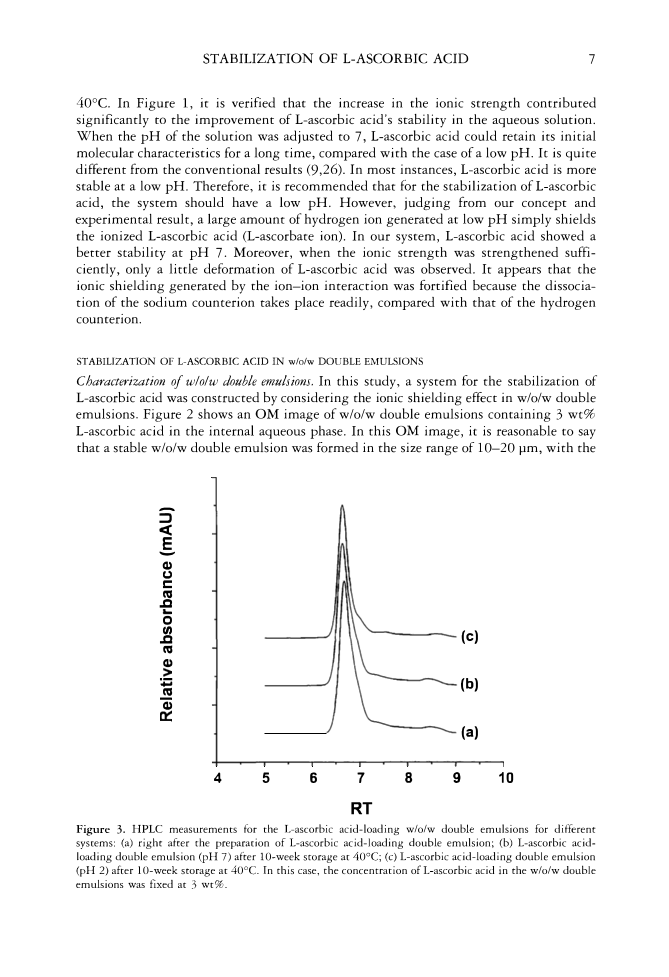STABILIZATION OF 1-ASCORBIC ACID 7 40°C. In Figure 1, it is verified that the increase in the ionic strength contributed significantly to the improvement of 1-ascorbic acid's stability in the aqueous solution. When the pH of the solution was adjusted to 7, 1-ascorbic acid could retain its initial molecular characteristics for a long time, compared with the case of a low pH. It is quite different from the conventional results (9,26). In most instances, 1-ascorbic acid is more stable at a low pH. Therefore, it is recommended that for the stabilization of 1-ascorbic acid, the system should have a low pH. However, judging from our concept and experimental result, a large amount of hydrogen ion generated at low pH simply shields the ionized 1-ascorbic acid (L-ascorbate ion). In our system, 1-ascorbic acid showed a better stability at pH 7. Moreover, when the ionic strength was strengthened suffi ciently, only a little deformation of L-ascorbic acid was observed. It appears that the ionic shielding generated by the ion-ion interaction was fortified because the dissocia tion of the sodium counterion takes place readily, compared with that of the hydrogen counterion. STABILIZATION OF L-ASCORBIC ACID IN w/o/w DOUBLE EMULSIONS Characterization of w/o!w dottble emttlsions. In this study, a system for the stabilization of 1-ascorbic acid was constructed by considering the ionic shielding effect in w/o/w double emulsions. Figure 2 shows an OM image of w/o/w double emulsions containing 3 wt% 1-ascorbic acid in the internal aqueous phase. In this OM image, it is reasonable to say that a stable w/o/w double emulsion was formed in the size range of 10-20 µm, with the - ::, ( -E Cl) (.J C ca .c 0 en (c) .c ca Cl) (b) ca Cl) (a) 4 5 6 7 8 9 10 RT Figure 3. HPLC measurements for the 1-ascorbic acid-loading w/o/w double emulsions for different systems: (a) right after the preparation of 1-ascorbic acid-loading double emulsion (b) 1-ascorbic acid loading double emulsion (pH 7) after 10-week storage at 40°C (c) 1-ascorbic acid-loading double emulsion (pH 2) after 10-week storage at 40°C. In this case, the concentration of 1-ascorbic acid in the w/o/w double emulsions was fixed at 3 wt%.
8 JOURNAL OF COSMETIC SCIENCE morphology of very fine internal water droplets. Moreover, it is evident that the presence of 1-ascorbic acid in the internal aqueous phase didn't have any influence on the morphological change. Stability of L-ascorbic acid in wlo!w dottble emttlsions. The stability of 1-ascorbic acid in the w/o/w double emulsions was evaluated by HPLC measurements. Figure 3 shows ex amples of HPLC measurements. In the HPLC measurement, 1-ascorbic acid was de tected at 6. 7 min of retention time. From the linear regression of peak area to the concentration, the stability of 1-ascorbic acid in the w/o/w double emulsions could be determined precisely. The long-term stability of 1-ascorbic acid in the w/o/w double emulsions was measured at time intervals and shown in Figure 4. At low pH, 1-ascorbic acid could not avoid degradation, even in the w/o/w double emulsions. However, by merely applying ionic shielding, the stability could be fairly improved, which shows a good accordance with the solutions shown in Figure 1. For a certain time, the stability was good. In the long run, however, the stability started to drop. In contrast, a dramatic improvement in stability could be achieved at pH 7. When ionic shielding was applied appropriately to the internal aqueous phase of w/o/w double emulsions, the initial stability of 1-ascorbic acid could be maintained for a long time, even at a high temperature. This reveals that ionic shielding plays a crucial role in stabilizing 1- ascorbic acid. The effect of loading amount on the stability of 1-ascorbic acid was also observed. Figure 5 shows the stability of 1-ascorbic acid with storage time at different loading amounts. It could be found that the stability was not dependent on the loading amount of 1-ascorbic acid. From those results, it can be said that once a proper system - E (' ( 1.0 0.8 0.6 0.4 0.2 \•-� -------: T\ - ■- 0.::: pH 7 T -•- 0 wt.% Mg5O 4 , pH 7 -•- 0.5 wt.% Mg5O 4 , pH 2 -•- 0 wt.% Mg5O4, pH 2 O.O+---r--...--T""--.----,.-----.----T-----.------.-----. 0 2 4 6 8 10 Storage time (week) Figure 4. Stability of L-ascorbic acid in w/o/w double emulsions with the storage time (40 ° C) for different systems: -■-, 0.5 wt% MgSO4/pH 7 -•-, without MgSO4/pH 7 -.A.-, 0.5 wt% MgSO//pH 2 -T-, without MgSO4/pH 2.
Purchased for the exclusive use of nofirst nolast (unknown) From: SCC Media Library & Resource Center (library.scconline.org)





































































































































